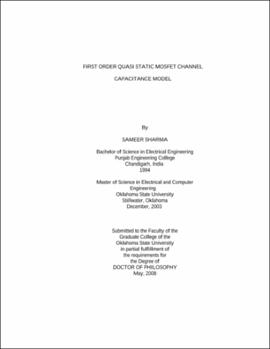| dc.contributor.advisor | Johnson, Louis G. | |
| dc.contributor.author | Sharma, Sameer | |
| dc.date.accessioned | 2013-12-10T18:05:51Z | |
| dc.date.available | 2013-12-10T18:05:51Z | |
| dc.date.issued | 2008-05 | |
| dc.identifier.uri | https://hdl.handle.net/11244/7872 | |
| dc.description.abstract | Scope and Method of Study: | |
| dc.description.abstract | Conventional MOS models for circuit simulation assume that the channel capacitances do not contribute to net power dissipation. Numerical integration of channel currents and instantaneous terminal voltages however shows the existence of first order dissipating terms. To overcome these limitations, and given that the accuracy of the simulation depends on the physical representation of the device, it is very important that we have a reliable mathematical model that is able to represent the device behavior. Designers need these accurate models for circuit development. | |
| dc.description.abstract | Findings and Conclusions: | |
| dc.description.abstract | To overcome the limitation of conventional charge based models, a self-consistent, first order, quasi-static, power dissipation model has been developed that is able to | |
| dc.description.abstract | Predict the exact solution to first order 1-D channel equations for MOSFETs without a channel charge partition approximation provided that the charge has a linear dependence on the channel potential. | |
| dc.description.abstract | Validate the terminal currents as being the same as Ward's channel charge partition approximation. | |
| dc.description.abstract | Validate that Ward's partition scheme is correct as long as the charge has a linear dependence on the channel potential. | |
| dc.description.abstract | Derive the first order channel charge (qc1 ) and current (ic1) as a function of position (x) inside the channel. | |
| dc.description.abstract | Derive the first order power dissipation and conserved components. | |
| dc.description.abstract | Estimate energy function. | |
| dc.description.abstract | Separate the terminal current into conserved and dissipative components. | |
| dc.description.abstract | Identify the inconsistencies in the BSIM power model. | |
| dc.description.abstract | In conclusion, there is a need to extend this work to include channel charge with a non-linear voltage dependence that does not generate extra power dissipation in the channel that has no physical basis. | |
| dc.format | application/pdf | |
| dc.language | en_US | |
| dc.rights | Copyright is held by the author who has granted the Oklahoma State University Library the non-exclusive right to share this material in its institutional repository. Contact Digital Library Services at lib-dls@okstate.edu or 405-744-9161 for the permission policy on the use, reproduction or distribution of this material. | |
| dc.title | First order quasi static MOSFET channel capacitance model | |
| dc.contributor.committeeMember | Scheets, George | |
| dc.contributor.committeeMember | Stine, James E., Jr. | |
| dc.contributor.committeeMember | Dai, H. K. | |
| osu.filename | Sharma_okstate_0664D_2669.pdf | |
| osu.accesstype | Open Access | |
| dc.type.genre | Dissertation | |
| dc.type.material | Text | |
| dc.subject.keywords | first order quasi-static mosfet | |
| dc.subject.keywords | first order power dissipation mos models | |
| dc.subject.keywords | mosfet channel capacitances | |
| dc.subject.keywords | mosfet eq | |
| thesis.degree.discipline | Electrical and Computer Engineering | |
| thesis.degree.grantor | Oklahoma State University | |
